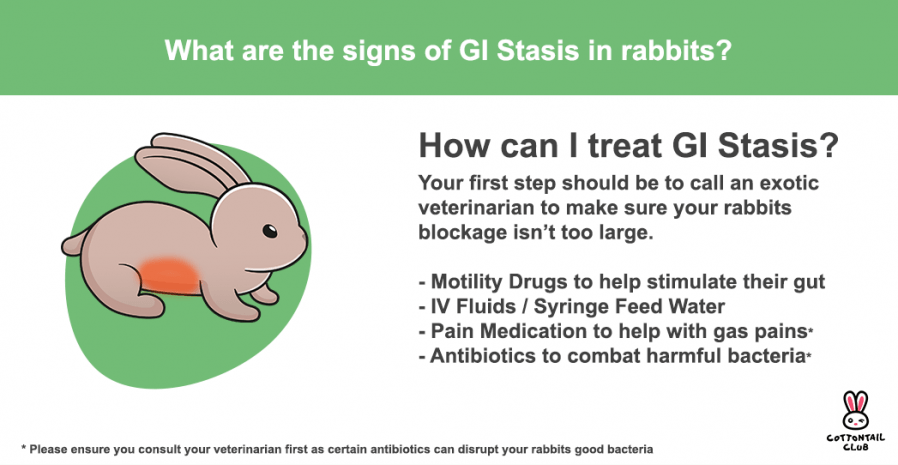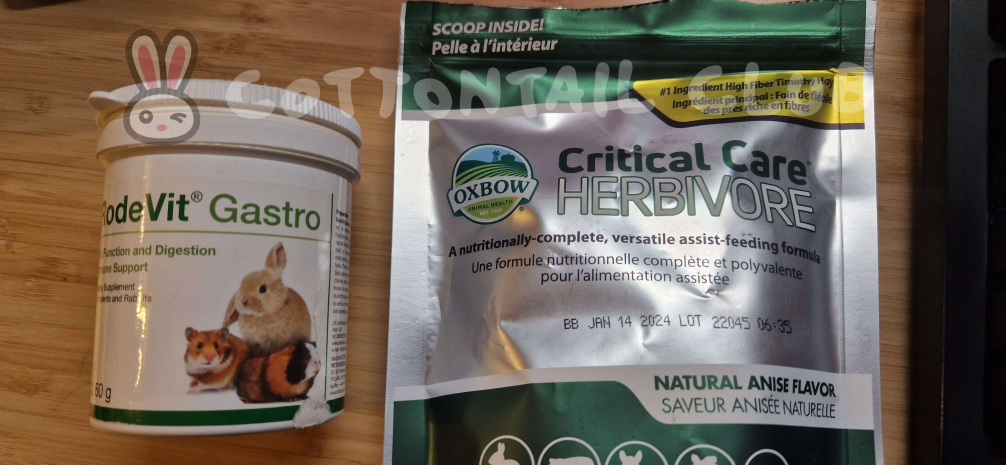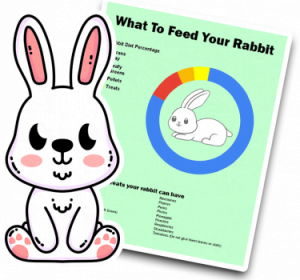
Every Rabbit owner should know the risk of gastrointestinal (GI) stasis as it is a common cause of domestic rabbit deaths. This serious condition can occur when your rabbit’s digestive system slows down or stops altogether, making it difficult for the rabbit to eat, drink, and defecate.
Left untreated, GI stasis can lead to serious health problems and even death. Fortunately, with early diagnosis and proper treatment, most rabbits fully recover. Learn more about GI stasis and how to protect your bunny from this potential danger.
Rabbits are prey animals, so they hide any signs of illness or health issues. This is due to predators targeting smaller and weaker animals first.
GI Stasis is a build-up of bad bacteria inside your rabbit’s intestines. This results in gas being released into their system, which can cause bloating. This bloating will make your bunny uncomfortable and stop them from wanting to eat or drink.
In a healthy rabbit, the stomach and intestines are constantly in motion, processing the fibrous diet that rabbits eat. This activity can produce quiet gurgling or humming sounds, which is generally a good sign that your rabbit’s digestive system is functioning as it should.
However, if your rabbit suffers from gastrointestinal (GI) stasis, a serious condition where the gut slows down or stops completely, these sounds may change. You might hear unusually loud gurgling noises, indicating gas buildup and discomfort. In severe cases, the gut may become so quiet that you hear nothing. This silence can signify that the gut has stopped moving, which is a sign of a medical emergency requiring immediate veterinary attention.
As a rabbit needs to digest and eat food continually, this can cause blockages in the digestive tract, resulting in your rabbit becoming dehydrated and starved of nutrients/roughage. The bacteria produced from this process will eventually release toxins that cause the liver to fail.

Spotting GI Stasis is quite difficult, so the best thing to do is to seek attention from your local Vet as soon as possible if you see any of these symptoms:
GI Stasis has many causes; some are easy to manage, and others require more input. The following are potential causes of GI Stasis:
There is no set time for GI Stasis to pass. This depends on the medication your rabbit is on. For example, when using Metoclopramide/cisapride, it may take two weeks for the gut to recover.
Some buns have seen a full recovery within 24 hours. It depends on how quickly it is caught, the age of your rabbit, and if they have any other health issues.
GI Stasis can easily be prevented by taking the necessary steps to keep your bunny healthy. The most crucial step is ensuring your rabbit has a consistent and healthy diet. Knowing what to feed your rabbit, the pellets, and the hay type can be confusing.
Fruit can be beneficial for Gastrointestinal Stasis as the fruit will pass through your rabbit’s gut fairly quickly. This should only ever be given in small portions.
Regular checkups at your vet can prevent any underlying issues which may cause Stasis, such as tooth pain from molar spurs, UTIs, and regular Gas. We suggest taking your rabbit to the vet at least once every 3 months for regular checkups.
Lastly, make sure your rabbit gets plenty of exercise. They should have at least 4 hours of free-roaming per day. Our rabbit, Link, is out from 6 am to midnight daily. Now, he is in a routine he puts himself to bed or sleeps in our bedroom doorway.
Regardless, your rabbit should exercise as much as possible during the early periods of the morning and late in the evening.
If you find yourself unable to take your rabbit to the vet immediately (Which we highly recommend as a priority), there are some things you can do at home to address GI stasis. However, please remember that seeking professional veterinary care is crucial for your rabbit’s well-being.

Your rabbit may need an X-Ray to assess where the blockage is and if there is any excess gas. This will determine how bad the stasis is and if surgery is required.
Other alternatives and solutions can be:
During this period, your rabbit should be surrounded by an unlimited supply of hay and vegetables in case they get hungry. Giving your rabbit a treat-based green such as cilantro may give your rabbit the motivation to eat and start the flow of digestion in their gut.
Additionally, if your rabbit is open to it, you can give them stomach massages, which may help kick-start gut movement.
All of this can be pretty expensive, and GI Stasis Treatment costs can be considerably high depending on your veterinarian and their rates. Some vets will allow you to pay via a payment plan or your pet insurance plan. Be sure to ask about this as soon as possible, even during this challenging period of time.
Unfortunately, there are no specific statistics for the survival rate of GI Stasis among rabbits, and this may be because GI Stasis can occur multiple times throughout a rabbit’s lifespan. The survival rate for rabbits with GI stasis varies widely and depends on several factors, including the severity of the condition, the underlying cause, and how quickly treatment is initiated.
With prompt and aggressive treatment, many rabbits can recover from GI stasis. However, if left untreated, GI stasis can be fatal within 24 to 48 hours.
It’s also important to note that preventing GI stasis is often easier than treating it. A diet high in fiber, particularly from hay, can help keep the gut moving and prevent stasis. Regular exercise and minimizing stress are also important for maintaining a healthy digestive system.
Remember, every rabbit is unique and may have different health needs. Always consult your veterinarian to ensure your rabbit gets the best care for their specific needs.
Yes, rabbits can recover from GI stasis with timely and appropriate medical care. GI stasis is a serious condition where the rabbit’s digestive system slows down or stops. Seeking immediate veterinary attention is crucial. With proper treatment, including medication, fluid therapy, feeding support, and monitoring, many rabbits can make a full recovery within several days to a week.
in most cases, you may start to see some improvement within a few hours to a couple of days after administering the medication.
The dosing frequency for Metacam in rabbits can vary based on the condition being treated and the individual rabbit’s needs. Typically, Metacam is administered once daily in rabbits, and your veterinarian determines the dosage based on your rabbit’s weight and the severity of the condition.
Metacam is a prescription medication commonly prescribed by veterinarians to treat pain and inflammation in rabbits. As it requires a prescription, you cannot purchase Metacam over-the-counter without a veterinarian’s approval.
This is something you will need to consult with the veterinarian who provided you with the Metacam. Alternatively, check the instructions inside the packaging for further guidance.
Barbara L. Oglesbee, DVM, Diplomate ABVP (Avian), and Jeffrey R. Jenkins, DVM, Diplomate ABVP (Avian)
“Pain Management in Rabbits” – World Small Animal Veterinary Association (WSAVA)

By entering your email address you agree to receive emails from Cottontailclub. We'll respect your privacy and you can unsubscribe at any time.